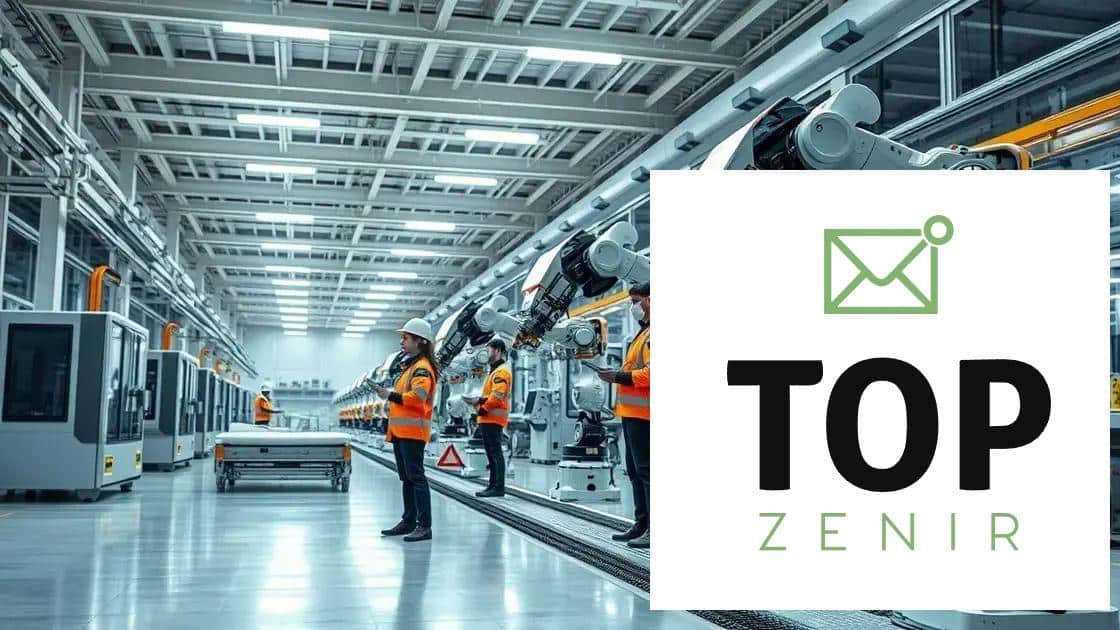Polyfunctional robots redefine industrial automation

Polyfunctional robots redefine industrial automation by performing multiple tasks efficiently, enhancing productivity, and fostering collaboration between humans and machines in various industries.
Polyfunctional robots redefine industrial automation by taking on multiple tasks, increasing productivity, and optimizing operations.
Have you ever wondered how these advanced machines could shape the future of manufacturing?
Understanding polyfunctional robots
Understanding polyfunctional robots can be fascinating. These machines are designed to perform various tasks across different environments. They combine flexibility and efficiency, making them invaluable in modern manufacturing. Imagine a factory where one robot can handle assembly, packaging, and quality control.
What Are Polyfunctional Robots?
Polyfunctional robots are advanced machines that can carry out multiple functions within a production line. Their design allows them to adapt to various processes, reducing the need for specialized robots. This adaptability leads to significant cost savings and efficiency improvements.
Benefits of Polyfunctional Robots
Moreover, polyfunctional robots can enhance productivity levels. By integrating sensors and smart technologies, they constantly analyze performance metrics. This feedback loop helps in optimizing production processes. In a world where speed and accuracy are paramount, such technologies ensure that businesses stay competitive.
Humans and robots can work together seamlessly in this environment. For example, while a polyfunctional robot handles repetitive tasks, human workers focus on more complex operations. This combination not only improves workflow but also boosts employee satisfaction.
Applications Across Industries
Polyfunctional robots are used in various industries, such as automotive, electronics, and pharmaceuticals. In the automotive sector, they assist in assembly lines, painting, and welding. In electronics, they help with precise tasks like picking and placing components. As companies expand their production lines, the ability to adapt to new tasks is crucial.
Overall, the understanding of polyfunctional robots reveals their importance in revolutionizing industrial practices. Their versatility and efficiency make them the backbone of modern automation systems.
Advantages of polyfunctional robots in industry

The advantages of polyfunctional robots in industry are significant and impactful. These robots enhance production processes, providing numerous benefits to manufacturers. They can perform a variety of tasks, ultimately leading to increased efficiency and productivity.
Key Benefits
- Improved Efficiency: Polyfunctional robots streamline operations by taking on multiple roles, reducing downtime.
- Cost Savings: With fewer machines needed, companies can save on initial investments and maintenance.
- Flexibility: They can quickly adapt to changes in production needs or product designs.
- Quality Control: These robots often include advanced sensors that ensure high-quality results.
Incorporating polyfunctional robots into manufacturing systems allows for smoother workflows. They are equipped with machine learning algorithms, enabling them to learn and adapt over time. This means they can improve their performance, reducing errors and increasing output consistently. For example, a polyfunctional robot may be involved in assembling parts, packaging products, and conducting inspections—all without needing to stop or reconfigure.
As industries face increasing demands for higher productivity, the value of polyfunctional robots becomes even clearer. They create a more sustainable production environment by lowering energy consumption and waste. Manufacturers can not only fulfill their orders faster but also reduce their overall environmental impact.
Case Studies in Various Industries
Several sectors have benefited from adopting polyfunctional robots. In the automotive industry, for instance, these robots manage complex assembly tasks while ensuring precision. In electronics, they handle delicate components, highlighting their versatility across different applications.
Ultimately, the advantages of polyfunctional robots extend beyond just cost and efficiency. They foster innovation and encourage businesses to rethink traditional manufacturing methods. As technology continues to advance, their role in industrial automation will only grow, making them essential for keeping up with market demands and driving progress.
Real-world applications of polyfunctional robots
Real-world applications of polyfunctional robots are transforming industries around the globe. These robots are designed to perform a variety of tasks, making them essential in modern manufacturing environments. By adapting to different roles, they help companies increase productivity and efficiency.
Manufacturing Sector
In the manufacturing sector, polyfunctional robots play a vital role. They can handle tasks such as assembly, welding, and painting. This versatility allows manufacturers to streamline their production lines. For instance, a single robot can switch from assembling parts to applying paint without needing major reconfiguration.
Logistics and Warehousing
Logistics and warehousing also benefit from these advanced robots. They are used for packing, sorting, and even transporting goods within a facility. As e-commerce grows, the need for efficient warehousing solutions has increased. Polyfunctional robots can load and unload pallets, reducing the time spent on these tasks significantly.
Healthcare Industry
In the healthcare industry, polyfunctional robots assist in various capacities. They can perform surgeries, prepare medications, or even assist nurses with patient care. Their precision and reliability help improve patient outcomes and reduce the risk of errors.
Educational institutions are exploring the use of polyfunctional robots for training purposes. Students can interact with these robots, gaining hands-on experience in programming and automation. This prepares future generations for careers in technology and engineering.
From small-scale operations to large factories, the adaptability of polyfunctional robots makes them the backbone of automation. Their applications are continually expanding as technology improves. Industries that embrace these robots can achieve significant competitive advantages in the market.
Challenges in integrating polyfunctional robots
Integrating polyfunctional robots into existing systems presents several challenges. As industries rush to adopt these advanced technologies, understanding these obstacles is crucial for successful implementation. From technical difficulties to workforce adaptation, companies must navigate various issues.
Technical Challenges
One major challenge is ensuring that these robots can seamlessly work with current manufacturing systems. Compatibility issues may arise, requiring companies to invest in new infrastructure or software. Additionally, programming polyfunctional robots can be complex, needing skilled personnel to set them up correctly.
Workforce Adaptation
Another significant hurdle is the impact on the workforce. Employees may feel threatened by the introduction of polyfunctional robots, fearing job displacement. Companies need to address these concerns through training programs that help workers adapt to the new technology. By offering upskilling opportunities, employees can learn to work alongside robots rather than be replaced by them.
Maintenance and Upkeep
Ongoing maintenance is also a critical issue. Polyfunctional robots require regular servicing to ensure optimal performance. Companies may face challenges in finding qualified technicians who can handle advanced robotic systems. This can lead to increased downtime, impacting productivity.
Furthermore, the initial investment costs can be a barrier for many organizations. While the long-term benefits of adopting these robots are significant, the upfront expenses can deter smaller companies from making the transition. They may struggle to justify the costs without immediate returns on their investment.
Finally, manufacturers need to stay updated with rapidly changing technologies. As advancements occur, ongoing integration can be challenging. Keeping pace with innovations requires strategic planning and flexibility to incorporate new features.
Future trends in industrial automation with polyfunctional robots
Future trends in industrial automation with polyfunctional robots are poised to redefine how factories operate. These advancements promise increased efficiency and productivity while opening new avenues for innovation. As technology evolves, the integration of polyfunctional robots will become even more widespread.
Enhanced Collaboration
One trend is the enhanced collaboration between humans and machines. As robots become more sophisticated, they will work alongside human employees, taking on tasks that require precision and consistency. This collaboration will lead to improved workflows and greater safety on the factory floor.
Artificial Intelligence Integration
Another significant trend is the integration of artificial intelligence (AI) into robotic systems. With AI, polyfunctional robots can learn from their environments, adapt to changes in real-time, and optimize their performance. This will allow for smarter, more efficient operations.
Smart Factories
The concept of smart factories is gaining traction. In these environments, polyfunctional robots will communicate with other machines, gathering and sharing data to streamline operations. This interconnectedness will lead to faster production times and reduced waste.
Increased Customization
As companies strive for greater customization in their products, polyfunctional robots will play a key role. They will be able to quickly adapt to different production tasks based on customer needs. This adaptability will be essential for businesses looking to stay competitive in a rapidly changing market.
Moreover, sustainability will become a top priority. Polyfunctional robots designed for energy efficiency will help reduce environmental impact. Companies are more likely to adopt practices that support eco-friendly operations, contributing to a healthier planet.
Overall, the future of industrial automation with polyfunctional robots is bright. As these technologies continue to advance, they will create more agile and responsive manufacturing systems, ultimately transforming the way industries operate.
Polyfunctional robots are changing the landscape of industrial automation. They enhance efficiency, promote collaboration, and adapt to various tasks. As technology advances, these robots will drive industries toward a more sustainable and productive future. Embracing these changes is essential for companies looking to thrive in a competitive market.
FAQ – Frequently Asked Questions about Polyfunctional Robots in Industrial Automation
What are polyfunctional robots?
Polyfunctional robots are advanced machines designed to perform multiple tasks in various environments, enhancing efficiency in industrial settings.
How do polyfunctional robots improve productivity?
They streamline operations by taking on diverse roles, which reduces downtime and increases overall output in manufacturing processes.
What challenges come with integrating polyfunctional robots?
Challenges include technical compatibility with existing systems, workforce adaptation, ongoing maintenance, and high initial investment costs.
What is the future of industrial automation with polyfunctional robots?
The future includes enhanced collaboration with humans, AI integration, the rise of smart factories, and increased focus on sustainability in manufacturing.





